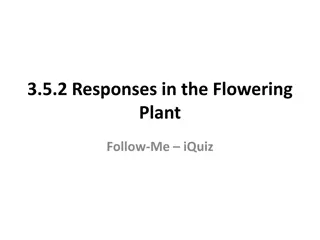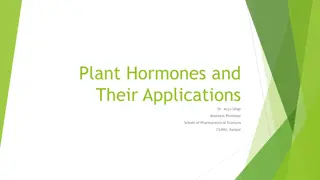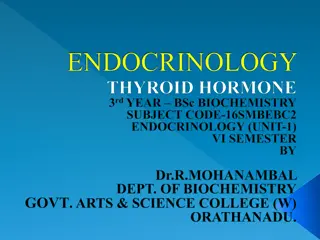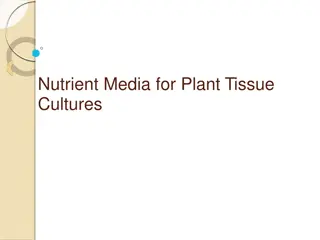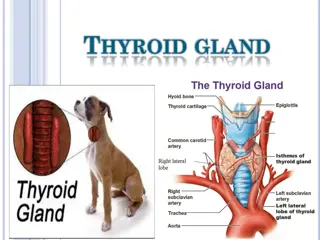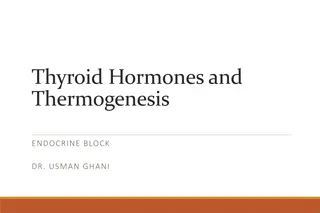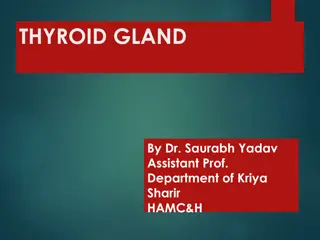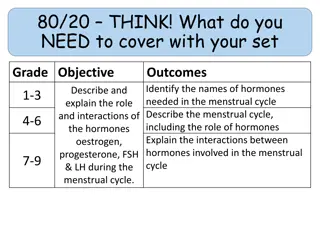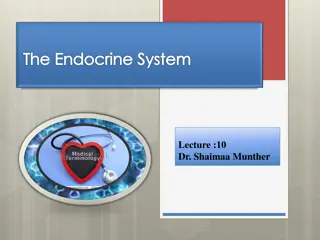Understanding Plant Hormones and Growth Regulators
Plant growth regulators, also known as plant hormones, play a crucial role in regulating growth and development in plants. They are organic compounds that act at low concentrations to promote, inhibit, or modify growth processes. The main plant hormones include auxins, cytokinins, gibberellins, abscisic acid, and ethylene. Each hormone has specific functions such as promoting female sex organ development, influencing apical dominance, and regulating fruit development. Understanding these hormones is essential for improving plant growth and productivity.
Download Presentation

Please find below an Image/Link to download the presentation.
The content on the website is provided AS IS for your information and personal use only. It may not be sold, licensed, or shared on other websites without obtaining consent from the author. Download presentation by click this link. If you encounter any issues during the download, it is possible that the publisher has removed the file from their server.
E N D
Presentation Transcript
PLANTHORMONES OR PLANT GROWTH REGULATOR
CONTENTS Introduction Classification Auxin Cytokinins Gibberellins Abscisic acid Ethylene Previously asked questions References
INTRODUCTION Plant growth regulators may be defined as any organic compounds, which are active at low concentrations in promoting, inhibiting or modifying growth and development. The term Hormone is derived from a Greek root hormao which means to stimulate Thimann (1948) suggested using the term Phytohormone for Hormones of plant. The naturally occurring growth substances are commonly known as plant hormones, while the synthetic ones are called growth regulator. Plant hormone is an organic compound synthesized in one part of the plant and translocated to another part, where in very low concentrations it causes a physiological response. The plant hormones are identified as promoters (auxins, gibberellin and cytokinin), inhibitors (abscissic acid and ethylene).
CLASSIFICATION There are five major plant growth regulators which includes: 1)Auxin 2) Cytokinins 3) Gibberellins 4)Abscisic acid (ABA) 5) Ethylene Growth promoters Growth inhibitors
TYPES OFAUXINS Indole acids: indole-3-propionicacid (IPA)
Naphthalene acids Naphthalene aceticAcid (NAA) -Naphthoxyacetic Acid (NOA)
Chlorophenoxy acids 2,4-Dichlorophenoxyacetic acid 2,4,5-Trichlorophenoxyacetic acid
Benzoic acids 2,4,6-Trichlorobenzoicacid 3,6-dichloro-2-methoxybenzoic acid
ROLE OFAUXIN Development of the female sex organ Auxins promotes development of female sex organ in flowers along with ethylene. Apical dominance Growth of the shoot apex (terminal shoot) usually inhibits the development of the lateral buds on the stem beneath. This phenomenon is called apical dominance. Fruit development Pollination of the flowers of angiosperms initiates the formation of seeds. As the seeds mature, they release auxin to the surrounding flower parts, which develop into the fruit that covers the seeds
A B Plant B has apical bud removed so auxiliary buds grow.
Root initiation and development The localized accumulation of auxin in epidermal cells of the root initiates the formation of lateral or secondary roots. Auxin also stimulates the formation of adventitious roots in many species. Adventitious roots grow from stems or leaves rather than from the regular root system of the plant. Phototropism Plant bend towards unilateral light. This is due to higher concentration of auxin on the shaded side. Partinocarpy Induces parthinocarpy. i.e. direct Development of ovary in to fruit without fertilization.
Evidence for the role of auxin in adventitious root formation Withsynthetic auxin Withoutsynthetic auxin Adventitious rootsgrowing from stem tissue Saintpaulia(Gesneriaceae family) (African violets)
CYTOKININS This was discovered in the course of studies involved in identifying factors that stimulate plant cells to divide. Cytokinins were discovered by Folke Skoog, Carlos Miller and co-workers in 1955. F. skoog discovered that degraded DNA after autoclaving was able to induce cell division in Tobacco pitch tissue. After thorough analysis of the degeaded product of DNA it was found that the active component was 6-fufuryl amino purine (6-furfuryladenine), and it was named as kinetin. The naturally occurring cytokinins are cis- trans-zeatin (ZEA), dihydrozeatin, isopentenyladenine(IPA) etc. The synthetic Cytokinins are kinetin, N-N diphenylurea, 6-benzylaminoprine(BAP) etc.
ROLE OF CYTOKININS Regulates the cell cycle/cell division (hence,the name "cytokinins) especially by controlling the transition from G2 to mitosis. Control morphogenesis In plant tissue cultures, cytokinin is required for the growth of a callus (an undifferentiated, tumor-like mass of cells). Greening Promotes the light-induced formation of chlorophyll. Bud development Direct application of cytokinin promotes the growth of axillary buds.
Delay senescence senescence is the programmed aging process that occurs in plants (and other organisms for that matter). loss of chlorophyll, RNA, protein and lipids. cytokinin application to an intact leaf markedly reduces the extent and rate of chlorophyll and protein degradation and leaf drop. It delays the ageing of the plant.
Transgenic SAG12-IPT plant Nicotiana (Solanaceae family) (Tobaccoplant) Comparison of a transgenic SAG12-IPTplant with the wild type, Note the significantly delayed leaf senescence in the transgenic plant.
GIBBERELLINS Gibberellins (GAs) were first isolated from the fungus Gibberella fujikuroi in 1926 by Japanese scientist E. Kurosawa G. fujikuroi causes baka nae (foolish seedling) disease in rice, causing Excessive shoot elongation, Yellowish green leaves taller plants with absent or poorly developed grains Frequent lodging due to long stature Chemical was extracted & purified and named as GibberellicAcid (GA). Now 80 different Gibberellins are available- GA1 to GA80 is available. The most commonly occurring gibberellins is GA3.
ROLE OF GIBBERELLINS Promotes stem elongation When applied to intact plants, GAusually causes an increase, unlike auxin. It overcomes dwarfism in mutants .
Overcomes dormancy in seeds Dormancy is a period in an organism's life cycle when growth, development, and (in animals) physical activity are temporarily stopped. Gibberellins also have a fundamental role in breaking seed dormancy and stimulating germination. Many forms of dormancy are broken by GA. These include seed dormancy, dormancy of potato tubers and dormancy of shoot internodes and buds. GAcan induce fruit enlargement External application of gibberellins can also enlarge fruit size in grapes
Sex expression In plants with separate male and female flowers, GA application can determine sex. For example, in cucumber and spinach, GAtreatment increases the proportion of male flowers. In maize, GAtreatment causes female flower development. Involved in parthenocarpic fruit development Development of fruit without fertilization . The fruit resembles a normal fruit, but it is seedless GAcauses ovaries to mature without fertilization and produces bigger fruits.
Germination Gibberellins are involved in the natural process of germination. Before the photosynthetic apparatus develops sufficiently in the early stages of germination, the stored energy reserve of starch nourish the seedling. Flowering Exogenous GAapplication can induce flowering in species that ordinarily require cold treatment to bloom.
ABSCISICACID(ABA) ABA plays a major role in adaptation to abiotic environmental stresses, seed development, and germination. Abscisic acid is an important growth regulator for induction of embryogenesis. This is a growth inhibitor.
ROLE OFABSCISICACID Seed Dormancy ABAplays a major role in seed dormancy During seed maturation,ABAlevels increase dramatically. This inhibits germination and turns on the production of proteins that enable the embryo to survive dehydration during seed maturation.
ABA induces stomatal closure ABA is one signal that causes guard cells to release solutes and thus release water, makingthem flaccid(compressed/shrink) and closing the stoma (pore) between them Solutes (e.g. potassium and chloride ions) accumulate in guard cells causing water to accumulate in guard cells, making them turgid(swollen from water uptake.)
Drought resistance Abscisic acid is the key internal signal that facilitates drought resistance in plants Under water stress conditions, ABA accumulates in leaves and causes stomata to close rapidly, reducing transpiration and preventing further water loss. ABA causes the opening of efflux K+ channels in guard cell plasma membranes, leading to a huge loss of this ion from the cytoplasm. The simultaneous osmotic loss of water leads to a decrease in guard cell s turgidity, with consequent closure of stomata.
Inhibition of bud growth and shoot formation. Abscisic acid owes its names to its role in the abscission of plant leaves. In preparation for winter, ABA is produced in terminal buds. This slows plant growth and directs leaf primordia to develop scales to protect the dormant buds during the cold season.
ETHYLENE It is the only gaseous hormone of plants. It is produced naturally by higher plants and is able to diffuse readily, via intercellular spaces, throughout the entire plant body In 1934, Gane identified that plants could synthesise ethylene and in 1935 Crocker proposed ethylene to be the hormone responsible for fruit ripening and senescence of vegetative tissues. Apples and pears are examples of fruit that produce ethylene with ripening. Ethylene is responsible for the changes in texture, softening, color, and other processes involved in ripenining.
ROLE OF ETHYLENE Fruit ripening Under natural conditions, fruits undergo a series of changes, including changes in colour, declines in organic acid content and increases in sugar content. In many fruits, these metabolic processes often coincide with a period of increased respiration, the respiratory climacteric . During the climacteric there is also a dramatic increase in ethylene production. Ethylene can initiate the climacteric in a number of fruits and is used commercially to ripen tomatoes, avocados, melons, kiwi fruit and bananas.
Shoot Growth Applied ethylene has the capacity to influence shoot growth. Application of ethylene to dark-grown seedlings can cause reduced elongation of the stem, bending of the stem and swelling of the epicotyl or hypocotyl. Ethylene treatment of seedlings promotes hook closure and stem thickening rather than elongation. These etiolated pea seedlings were treated with 0, 0.1 and 1 ppm ethylene (left to right)
Flowering The ability of ethylene to affect flowering in pineapples has important commercial applications . Growth effects Inhibits logitudinal but promotes horizontal growth. Breaks dormancy
REFERENCES Chawla H.S(2009 ) , Introduction to plant biotechnology(3rd edition), Science publishers, 22- 23 Edwin F. George, Edwin F. George, Michael A. Hall, Geert-Jan De Klerk (2007) - Plant Propagation by Tissue Culture.The Background, Volume 1,Springer,175-282



